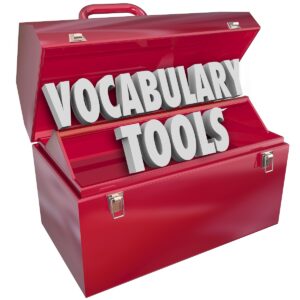Related Products
For Professionals
- Amplification
- Assessment of Student Skills, Challenges, Needs
- Early Childhood: Infants, Toddlers, Preschool
- Hearing Loss – Identification, Impact and Next Steps
- IDEA Law Summary Information
- Language and Speech Development Issues
- Legal Issues in Serving Children with Hearing Loss
- Listening (Auditory Skills) Development
- Planning to Meet Student Needs
- Self-Advocacy Skills for Students with Hearing Loss
- Self-Concept: How the Child with Hearing Loss Sees Himself
- Social Skills
- Speech Perception & Learning
Related Teacher Tools Takeout Items
Focusing on Vocabulary Building
Vocabulary building strategies are some of the most important tools an educator can have in her teaching toolbox, and teaching students to break apart words (morphology) is one of those strategies no teacher should be without. Quoting the film The Firm, “it’s not sexy, but it’s got teeth!”
Did you know…?

- Approximately 60% of English words are of Greek or Latin origin
- Twenty prefixes make up 97% of prefixed words in printed school English, and just four of those (un-, re-, in-, dis-) make up the first 58%
- Words with inflectional endings (plurals, possessives, s-v agreement, tense markers) account for most words students see/read
- By middle school, a student needs to have learned approximately 9,000 word families to comprehend academic reading texts
The ability to manipulate and analyze words is a critical skill for reading success. As teachers, we know that. A vocabulary goal is likely written into many IEPs. Whether signed, spoken, or both, word knowledge is what sets apart good readers. However, the task of learning the number of words being used each week is daunting for a student with language delays. In addition, a teacher can feel completely overwhelmed by the expansive number of words she is required to teach that student, knowing those language delays are present. Using time wisely is imperative and prioritizing which words and word parts are of the most importance becomes crucial.
Where to begin? I found myself beginning by choosing the most obscure words in a text, thinking that they needed the most emphasis. Now I know this was not the best way to go about teaching vocabulary. A better way for teachers to use their time and skill is to teach the highest frequency words and word parts first. For example, since the prefixes un-, re-in-, and dis- make up roughly 58% of all prefixed words, this is a great place to start. With inflectional endings such as plurals and possessives making up most of the words students see and read, they are another great place to begin.
As for word lists of the most commonly used content area vocabulary, https://lead4ward.com/resources/ is very helpful and provides lists by grade. I am also excited that Supporting Success has added two new resources for effective vocabulary instruction: Academic Vocabulary for Middle School Students by Greene and Coxhead, and the Vocabulary Handbook, by Diamond and Gutlohn. Each book includes excellent research-based lists for content areas and strategies for teaching the words our students really need to know to comprehend increasingly complex subject matter. Need help knowing exactly where to start? The Academic Vocabulary book includes a free downloadable Vocabulary Size Test to use with your students. The Vocabulary Handbook includes a pre/post-test for students to test their knowledge.
Another great resource for vocabulary instruction is Latin and Greek Roots, by Stokes. If you like hands on activities, Latin and Greek Roots has multiple activities using minimal preparation and common objects. Here you will find a fun way to teach words and word analysis. What are you waiting for? Seize the day!
Resources:
- Easterbrooks, S.R. & Beal-Alvarez, J. (2013). Literacy Instruction for Students who are Deaf and Hard of Hearing. New York: Oxford University Press.
- Greene, J.W. & Coxhead, A. (2015). Academic Vocabulary for Middle School Students: Research-based Lists & Strategies for Key Content Areas. Baltimore, Maryland: Paul H. Brookes Publishing Co., Inc.
- Diamond, L. & Gutlohn, L. (2019). Vocabulary Handbook. Baltimore, Maryland: Paul H. Brookes Publishing Co., Inc.
- Stokes, P.D. (2012). Latin and Greek Roots: Teaching Vocabulary Using Hands-on Activities and Common Objects. Austin, Texas: PRO-ED, Inc.
Click here to download this article, together with author information
